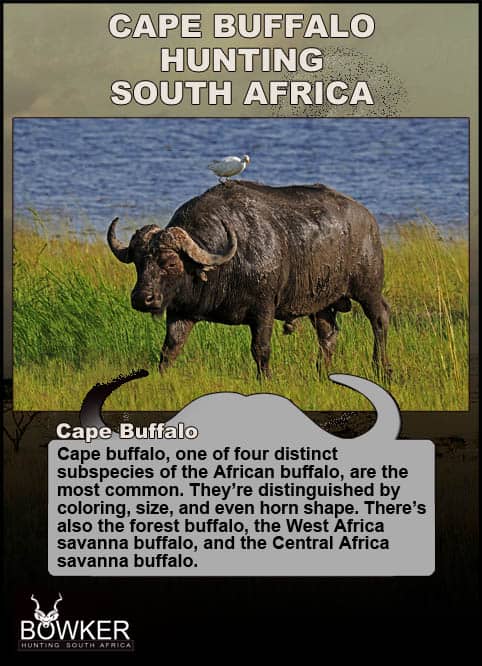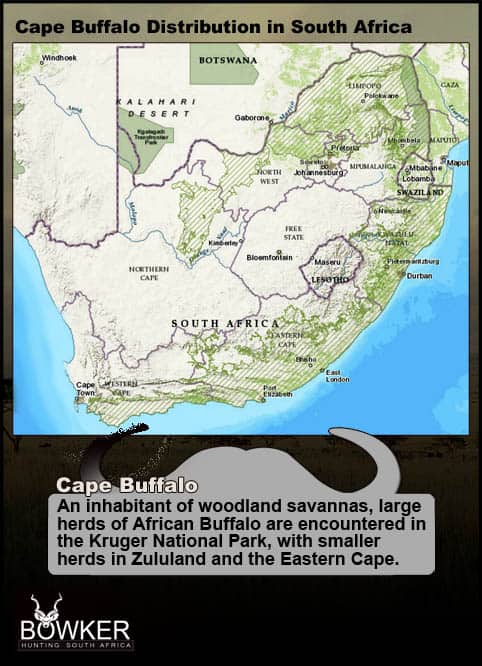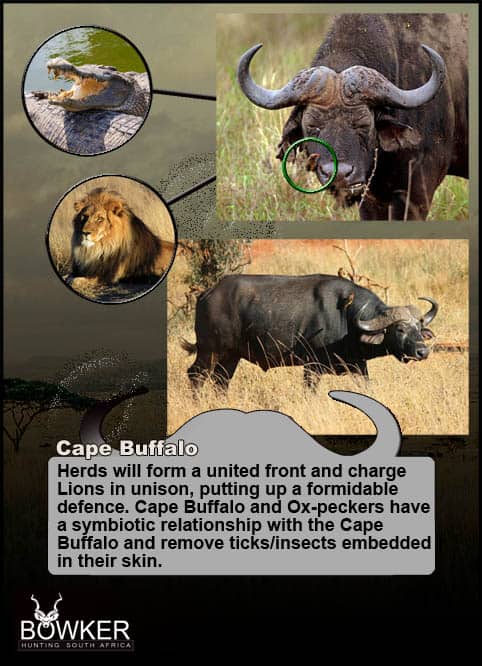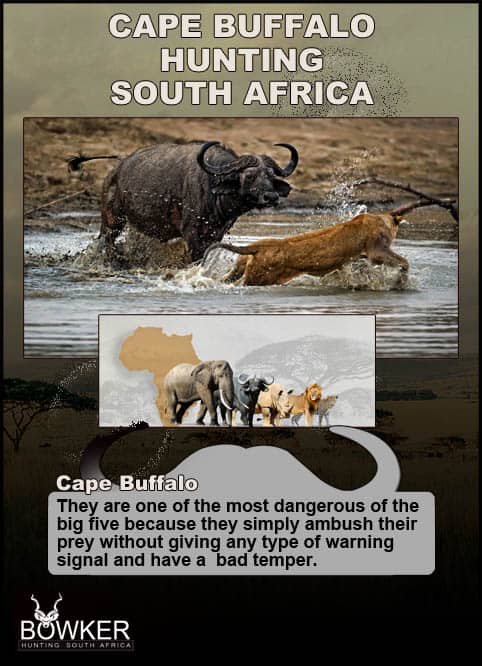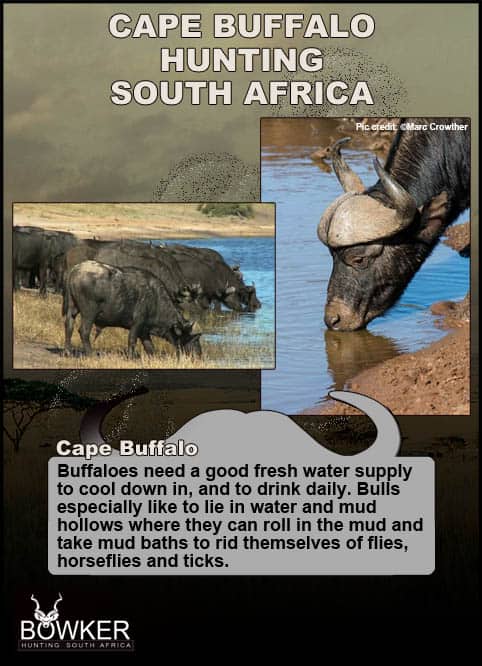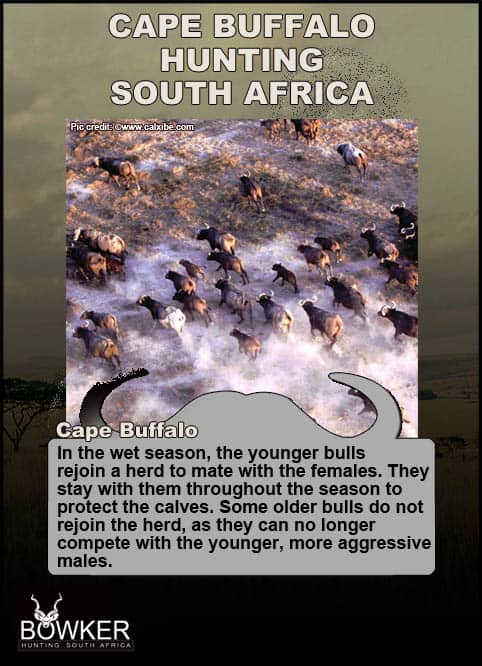
Summary
The Cape or African Buffalo trophy is the most popular dangerous game hunt on African hunting safaris.
Cape Buffalo kills more hunters than any other animal in Africa.
Buffalo are hunted on fenced farms in South Africa.
There are no seasonal restrictions on hunting Buffalo trophies in Eastern Cape, South Africa.
Nick Bowker Hunting offers Buffalo safaris year-round.
Hunting Cape Buffalo requires a minimum of .375 caliber.
Your outfitter professional hunter will also carry a rifle in case of a buffalo charge.
Cape Buffalo hunts are conducted by walking and stalking.
Your Buffalo hunt camp will be at Hopewell Safaris Lodge.
Shooting Buffalo is a once-in-a-lifetime experience.
Come and Buffalo hunt with Nick Bowker Hunting. Our concession area is challenging but has its own camp.

Table of Contents
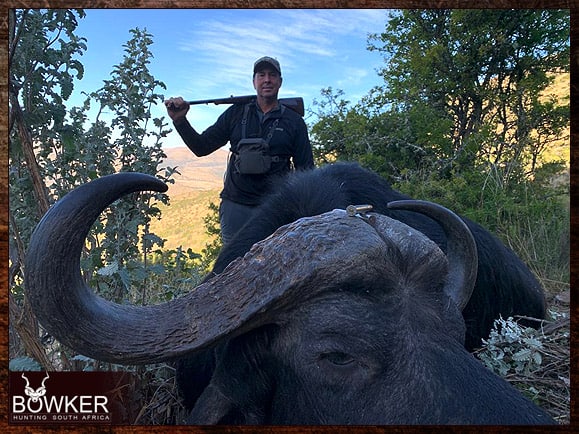
Cape Buffalo Trophy Fees in South Africa -2025
The average price of a Cape Buffalo bull in South Africa is between $11000 and $15000. Cape Buffalo can be added to any of our safari hunt packages, and we offer affordable hunting packages.
Our current price is $14500
Included in the Buffalo bull trophy hunting package is a licensed hunting guide. As well as a hunting license and all permits for hunting Buffalo.
Your professional hunter will be experienced with many years of guided buffalo hunting, including tracking wounded Buffalo.
Professional hunters have a healthy respect for a wounded Buffalo during safaris.
Cape Buffalo Hunting in South Africa
A buffalo trophy will have an average shoulder height of around 65 inches, weigh 1400 pounds, and have a horn length of 36 – 40 inches.
The Safari Club International minimum score for a cape buffalo is 101. Measure the length of the outside of the horn curl from tip to tip, plus the straight-line width measurement of both bosses for a combined total score in inches.
A 375-caliber rifle is the minimum legal requirement to hunt buffalo.
Buffalo hunting areas are widespread across the Eastern Cape. Generally, shooting Buffalo in South Africa is in a high-fenced area, and the size of the safaris areas varies widely.
If you want authentic free-range Buffalo, you must hunt with outfitters in Zimbabwe, Mozambique, or Tanzania.
However, the trade-off is that buffalo hunting safaris in South Africa are substantially cheaper on an all-in basis.
The day rates in countries like Zimbabwe for Buffalo are expensive and dramatically increase the overall hunt costs for outfitters.
Day rates reflect the taxes and fees paid to the government. In most cases, the land is not private, and the government owns the animals.
In South Africa, most land area is private, including the game.
Buffalo hunting in South Africa is still tremendously exciting and hunted by spot and stalk.
Your professional hunter is required to have a dangerous game license to hunt Buffalo on your Southern African safari.
In particular, the Buffalo bulls have learned to avoid humans, feed at night, and hide in thickly wooded areas during daylight, making buffalo safaris very tough.
Shooting Buffalo is considered a dangerous game rather than a plains game.

Shot placement must be in the bottom third of the buffalo of the animal directly above the front shoulder. This will ensure a heart or lung shot. Avoid head and neck shots, which are high-risk.
Trophy Judgement and Rifle Caliber for Hunting Cape Buffalo

As with most African game hunting, shot placement should always be in the bottom third of the shoulder. As a result, a well-placed shot, a rifle of .375 caliber, is adequate for shooting the Buffalo.
Nick Bowker Hunting has 375 rifles and ammunition for hunters not wishing to go through the red tape of bringing a rifle to South Africa. I’ve included for you the rifles and ammunition free of charge.
Robert Ruak famously wrote, “When coming face to face with a buffalo bull, he will look at you as if you owe him money”;… enough said.
A buffalo bull is the number one desired African trophy for international hunters worldwide dangerous animals to hunt.
A wounded buffalo bull can sometimes circle back, wait for the hunter along its track, and charge the hunter without warning.
Loud death bellows are the best sign of a dying buffalo, but not all will give this bellow.
With age, one will find old solitary bulls move off from the herd; these buffalo bulls are called “Dagga Boys” due to their enjoyment of regular mud baths, leaving caked mud on their backs, giving the appearance of dried cement (“Dagga”).
These bulls are the most challenging and fun to hunt and may sometimes form small “Dagga” buffalo groups.
A hard and solid boss for a buffalo is the number one sign of a great trophy. I want you to know that your professional hunter will be invaluable here.
Sometimes, these old bulls won’t carry a spread beyond 30 inches, as horns will wear down with age. These are, in fact, the best and most memorable trophies on a buffalo trophy hunt.
The Difference between a Male and a Female for Buffalo Hunting
The Cape Buffalo bull has a colossal lump or boss. Also, males are larger and will have thicker necks than females. In contrast, the female’s horns will have a gentle slope without the boss or helmet.
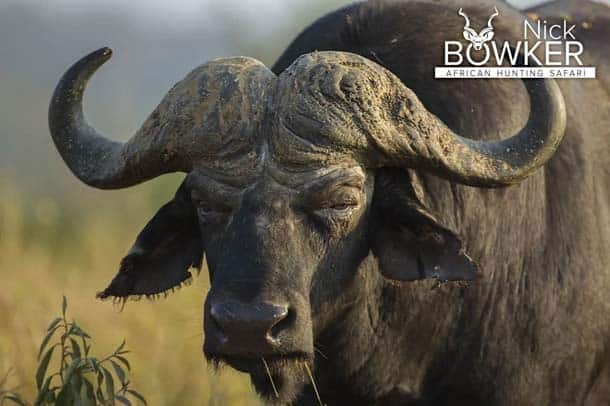
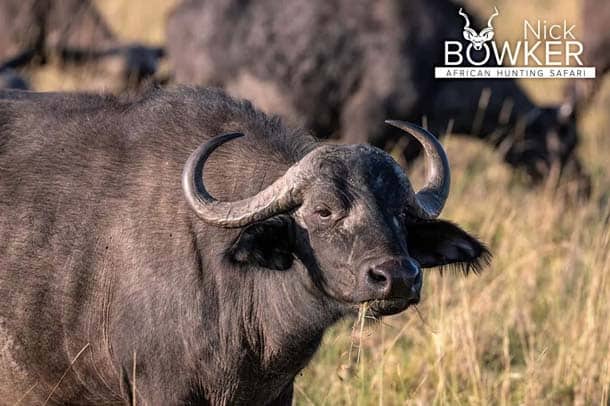
Interesting Facts for Cape Buffalo Hunts
- Buffalo hunting results in the death of more hunters than any other species. Also, buffalo are no slouches and can reach 56 KPH, that’s 15.6 meters per second.
- Herd mentality is powerful; sometimes, it will force a buffalo mother to abandon her calf.
- Pathfinders determine Buffalo’s movement. Despite this critical role, these animals do not have to be high-ranking.
- Rinderpest, a disease in the 1890s, nearly wiped out the buffalo; estimates say that for every buffalo that lived, 10,000 died.
- Buffalo eat a large quantity of coarse material, and they need to drink regularly, up to twice a day, managing as much as 34 liters in just 6 minutes.
- Buffalo kill lions, and if lions attack a herd of buffalo, they do so at significant risk as buffalo often retaliate with a mobbing attack against the lions.

- Older buffalo bulls choose to drop out of the herd and wander alone or in small groups away from the herd.
- Older males are called dagga-boys, referring to the Zulu word for mud, given their love for wallowing.
- African Buffalo have poor eyesight and hearing but an incredible sense of smell.
- Buffalo hide is as thick as two inches in certain parts.
- The Cape Buffalo is the largest subspecies in Africa.
- Buffalo are excellent swimmers.
- The African buffalo is not related to the water buffalo of Asia.
- A Buffalo bull is a must for all hunters; however, they are more expensive than other plains game hunts.
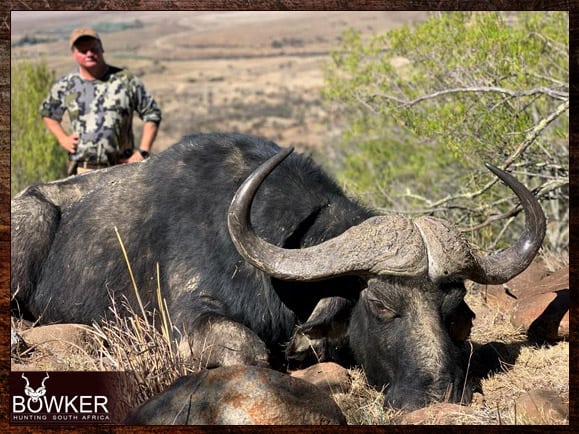
About the African or Cape Buffalo
Buffalo habitat includes mixed scrub woodland areas. They will occasionally venture onto plains only if there is an ample abundance of grasses but typically avoid such open areas to avoid becoming an easy target for their predators.
One of the “big five” African game, buffalo is known as “the Black Death” or “Widow Maker” and is widely regarded as a dangerous animal.
According to some estimates, buffalo gore and kill over 200 people yearly.
Buffalo kills more people in Africa than any other animal. However, hippos and crocodiles have the same claim.
Buffalo bulls are notorious among big-game hunters as dangerous animals, with wounded animals ambushing and attacking pursuers.
African Buffaloes weigh 1,100 to 2,200 lb, with males typically larger than females, reaching the upper weight range.
The horns of a buffalo form entirely when the animal reaches five or six years, but the bosses do not become “hard” till 8 to 9 years old.
In buffalo cows, the horns are smaller and do not have a boss.
African Buffalo are frequently preyed upon by lions. As a result, African Buffalo are known to rush to defend another herd member if a predator attacks it.
In a large group, buffalo can also ward off the pride of preying lions.
The Buffalo has many characteristics similar to the Blue Wildebeest but is a very different hunt!
Frequently Asked Questions About Hunts
How much does it cost to hunt a Cape Buffalo?

The trophy fee as a standalone Cape Buffalo hunt is between $9,000 – $13,000. Daily rates vary between $250 and $500 per day for safaris.
Included in the Cape Buffalo trophy fee is a licensed guide. As well as a hunting license and all permits for the hunt.
How to hunt a Cape Buffalo?
Cape Buffalo hunting is in the early mornings and late evenings and spotted from an elevated vantage point in the thick brush and then stalked. Alternatively, hunters use ambush techniques at watering holes or as they move back to cover from feeding.
Where do you shoot a Cape Buffalo?
Shot placement must be in the bottom third of the animal directly above the front shoulder. This will ensure a heart or lung shot. Avoid head and neck shots, which are high-risk for buffalo safaris.
What is a trophy, Cape Buffalo?
Cape Buffalo trophies have a Horn Length of approximately 36 – 40 inches. The minimum qualification score under Safari Club International for a Cape Buffalo is 101.
Measure the length of the outside of the horn curl from tip to tip, plus the straight-line width measurement of both bosses for a combined total score in inches for your buffalo.
Seasonal Restrictions on Hunting
When can you hunt Cape Buffalo in South Africa?
There are no seasonal restrictions on Cape Buffalo hunting in the Eastern Cape of South Africa.
What Caliber is Recommended for Cape Buffalo Hunts?
Hunt Cape Buffalo with a rifle minimum caliber of .375 in South Africa.
Cape Buffalo in Pictures
